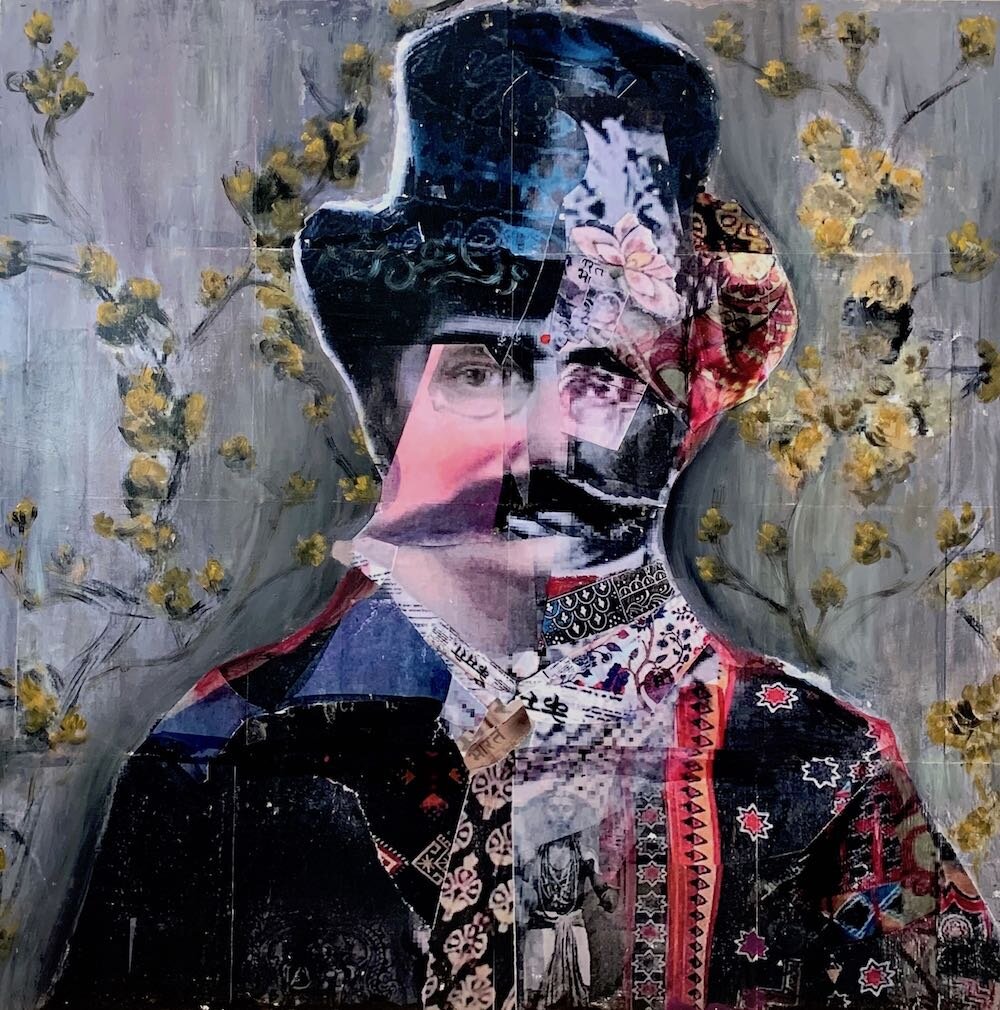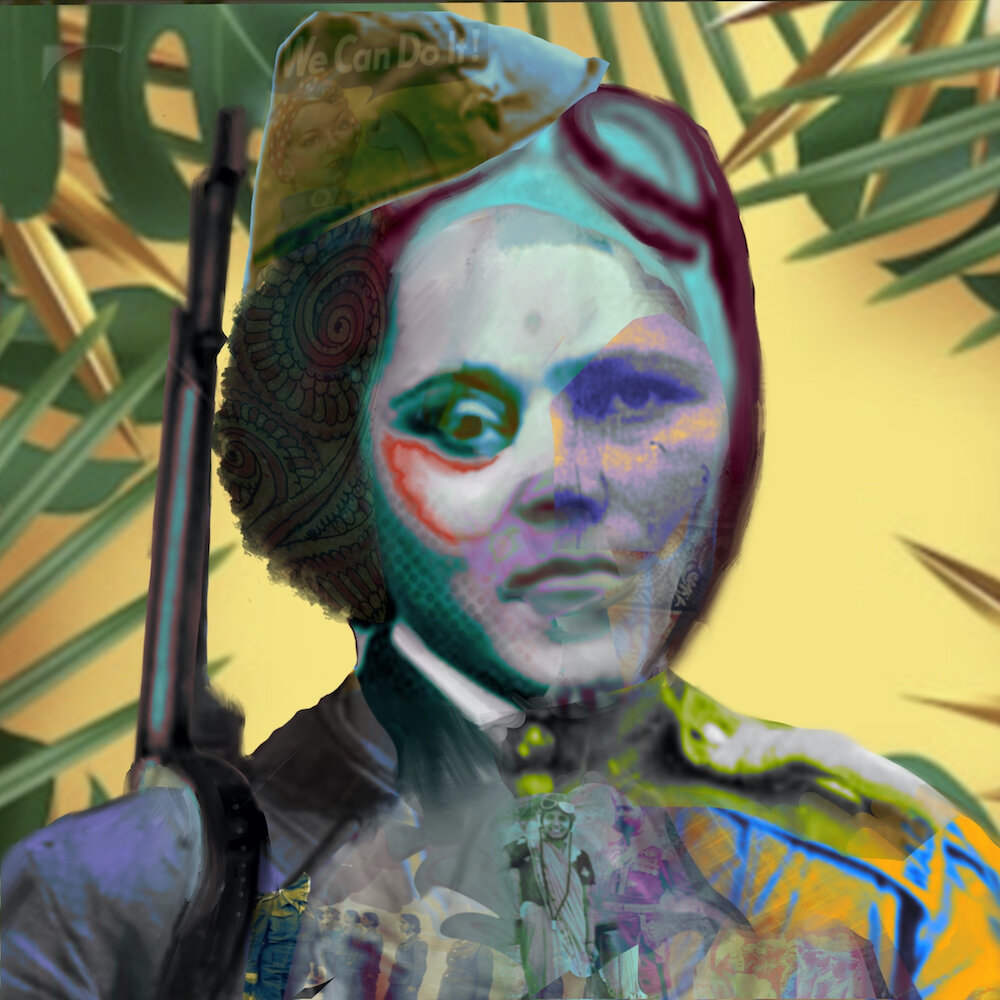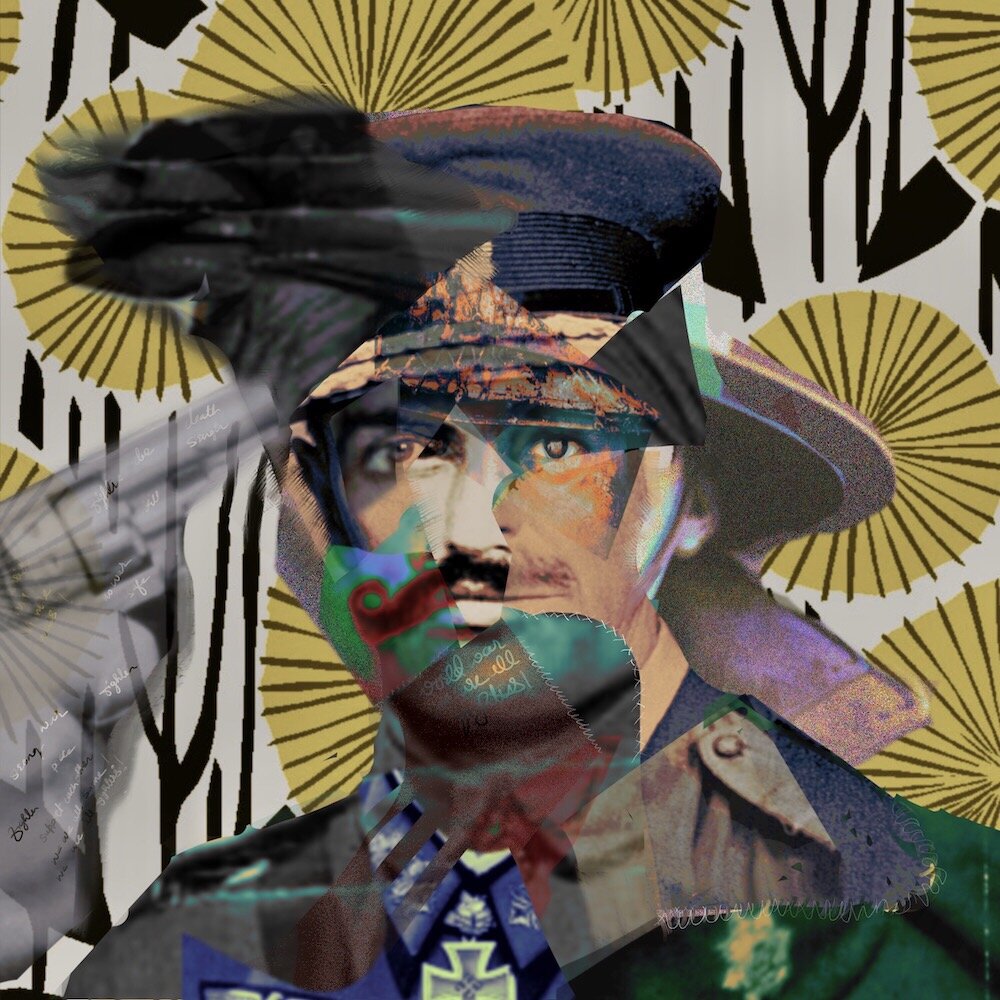Portrait of Nimisha
Nimisha Doongarwal
Nimisha is originally from India. She came to the United States in 2007 for Masters in Computer Science. After finishing her Master's, she realized her true passion was art for self-expression. Currently, she is doing MFA part-time and working as a full-time software engineer. Her art represents immigrant Identity by using cultural and colonial past.
Artist Statement:
Mixed media artworks Nimisha creates are grouped inventories of fragments: paintings, photographs, fabrics, and digital prints. The work explores the varying relationships between past and popular culture by referencing Indian and British history. Every image tells a unique story by creating visual links to history and reality. The portraits she creates have a new abstract identity, which emphasizes the cultural and traditional overlap, people around the world went through over the centuries. This overlap has made people extremely similar, irrespective of the varied physical appearances. Through her works, she wants to encourage people to embrace cultural diversity and reduce prejudice against groups based on color, race, religion, appearance, and so on. Her goal is to give a voice to social issues immigrants face around the world, though her art and advocate awareness.
Interview with Nimisha Doongarwal
Questions by Andreana Donahue
Can you tell us a bit about your background and where you grew up? In what ways have your early visual experiences and personal history led to art-making?
“An artist cannot fail, it is a success to simply be one”. This single sentence sums up for me what it is to be an artist, individuals who can immerse themselves in an occupation that they are passionate about. Although people can aspire to become artists for various reasons, for me it’s a lot simpler, I simply enjoy creating art. I am originally from Gwalior, M.P Central India and came to United States in 2007 to pursue a Masters in Computer Science from Utah State University, in Logan, Utah. I have been working as a Software Engineer after graduating from USU.
From an early age I have always had an inclination to paint, draw and sculpt. As a teenager I found that through my art I could communicate and form relationships with people through my work. I would be asked questions about what I had created and this would give me an opportunity to introduce them to the world of artistic expression and explain my views.
We are two sisters to a traditionally trained Indian artist mother, who later started working as a banker. As a child I used to copy my mother's paintings in order to learn and create my own interpretations of them. Also, I used to enjoy stitching, crafts and sculpting. We used to visit my maternal grandparents every summer, who lived in Udaipur, Rajasthan, a city known for its art and culture, and this has been a strong influence on my art since childhood.
Where are you currently based and what initially attracted you to working in this community? Are there any aspects of this place that have surfaced in your work?
Currently I live in San Francisco with my husband Santosh Shirahatti, I am an immigrant from India and an Engineer by profession. This project started as a self discovery to find my own Identity and belonging. Mixed media artworks Nimisha creates are grouped inventories of fragments: paintings, photographs, fabrics, and digital prints. The work explores the varying relationships between past and popular culture by referencing colonial history. Every image tells a unique story by creating visual links to history and reality. Being here in the USA and specially the bay area plays a big role in my art, this place and my surroundings is what pushed me to explore my identity and the identity and issues of an immigrant in general.
Who Am I? (2), 2019. Mixed media, 36 x 36”.
Can you tell us about your studio and what a typical day is like for you? Do you share space or ideas with other artists while working, or is it a more solitary routine?
My day-to-day looks very different from a regular artist's life. I work as an engineer during the day and by night get to my studio and explore my artistic side. I have been leading this dual life science 2013 and enjoy it a lot. Art keeps me close to emotions and the creative side and being an engineer keeps me analytical and confident. I do talk to other artists, go to galleries and museums and also talk a lot about art to my engineer friends, inspiration for my works comes from everywhere.
What criteria do you follow for selecting materials? Do you prefer to maintain a narrow focus or work across diverse media? How do you navigate the limitations and possibilities that result from this path?
For me my idea is the main force which leads me to choose style and materials. I can go from full oil based painting to a mixed media collage if my idea suits it best. I do multiple digital and small studies before creating an actual piece, this helps me narrow down the issue and figure out solutions.
Can you walk us through your overall process? How would you describe your approach to manipulating materials? What about decision-making and editing?
The biggest and most important part of my process is research which goes behind the images I select to create each piece. I start with reading about a specific topic relevant to colonial history, watch videos and collect inventory of images both historical and current, based on this. The images can be of people, places and patterns I find relevant to a topic. These images are then digitally juxtaposed to create a portrait. Once I have an initial digital image I start going back and forth between digital and physical medium. This involves photo collaging, image transferring, silkscreen and painting on the canvas. A lot of mark making involves tearing paper and putting them together, scratching surface, juxtaposing fabric, making brush marks etc. After this I take a photo of the finished painting with some of the surrounding and go back to add more details on this picture digitally. I keep following this process over a few times until the mixed media painting looks finished.
My process directly resonated with the way our identities are created over centuries, a mix of a lot of cultures, surrounding, our past and present. This is also the reason I chose to use mixed media rather than paintings, so that I could show the layers our identities are made of. One of the reasons I selected to show our cultural overlap through colonial past and historical imagery is because in my opinion that is when we actually started to evolve into these similar identities irrespective of our differences.
Who am I? (1), 2019. Mixed media, 36 x 36”.
Can you talk about some of the ongoing interests, imagery, and concepts that have informed your process and body of work over time? How do you anticipate your work progressing in the future?
My work is most influenced by social issues and current affairs. Each piece is a result of the social issues I see or read around me. My works can be best described as social political pieces which look like colorful abstract portraits from far and up close to a visual documentation of the issues in our contemporary society. I want to always create works which are pretty to look at but at the same time raise awareness in a way which is visually digestible. Reacher is key to my work and current affairs leads the oath for me so it's hard for me to say what's next, I certainly hope we, as a society, are done with discriminating against color,race, religion and so on.
Do you pursue any collaborations, projects, or careers in addition to your studio practice? If so, are there connections between the two?
I am a Software Engineer professionally and I like to think that it certainly adds a lot of value to what I am as an artist and vice versa, even though these professions might look like poles apart. I always say old masters knew it all, Leanardo was as great an artist as a scientist, why can't we be the same. An engineer can be a good artist and an artist can code [heheh].
As a result of the pandemic, many artists have experienced limited access to their studios or loss of exhibitions, income, or other opportunities. Has your way of working (or not working) shifted significantly during this time? Are there unexpected insights or particular challenges you’ve experienced?
I have started to work remotely and it's been hard to spend time on my art. Pandemic was a hard time especially with all the social unrest and acts of violence, it was mentally exhausting for me. By god's grace I didn't have financial troubles but it was surely hard to see that happening to people around me. As an artist and as a fellow citizen I have been trying to help as much as I can but this is just a very hard time and hope this gets over soon.
Master or Slave, 2020. Digital.
In a time that seems to be marked by uncertainty, collective anxiety, and increasing social unrest, why do you think the perspectives and contributions of artists remain meaningful? Do you feel a natural relationship exists between your work (or the role artists play more broadly) and confronting established systems - of power, cultural institutions, or otherwise?
Art has always played one of the most important roles in raising awareness and with the given situation it becomes more important than ever. We have a moral duty as artists to use the gift of art and help raise awareness. The portraits I create have a new abstract identity, which emphasizes the cultural and traditional overlap, people around the world went through over the centuries. This overlap has made people extremely similar, irrespective of the varied physical appearances. Through my works I want to encourage people to embrace cultural diversity and reduce the prejudice and in some cases crime against groups based on color, race, religion, appearance and so on. My goal is to give a voice to social issues immigrants face around the world, through my art and advocate awareness
Can you share some of your recent influences? Are there specific works - from visual art, literature, film, or music - that are important to you?
I watch a lot of books, articles and watch documents pertaining to immigrants and issues immigrants and refugees around the world face. I am a big fan of an Indian writer and politician Dr. Shashi Tharoor.
Identity, 2019. Mixed media, 30 x 40”.
Who are some contemporary artists you’re excited about? What are the best exhibitions you’ve seen in recent memory?
Njideka Akunyili Crosby and Hung liu are two women artists who have the most influence on my work. Both of them create these beautiful images which are beautiful to look at but have deeper meaning, they talk about issues in our society and make strong statements. I want to become an activist not just an artist. Art for me should hold a higher purpose than just lighting up one's living room. Saddest part about 2020 was that I couldn't go to museums and look at my favorite pieces in SFMOMA at least once every month.
What are you working on in the studio right now? What’s coming up next for you?
I have always been disturbed by the way religion, despite being the most beautiful thing, is the cause for most of the wars and issues in the world especially the middle east. My next project is going to be about religion and its effects on the world both good and bad.
What are you working on in the studio right now? What’s coming up next for you?
I have always been disturbed by the way religion, despite being the most beautiful thing, is the cause for most of the wars and issues in the world especially the middle east. My next project is going to be about religion and its effects on the world both good and bad.







